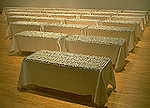Return to:

Bolts from the Blue
By ADRIENNE M. GOLUB
As many of us transplanted Northerners eventually discover—not happily I might add—the Tampa Bay area is apparently the "lightning capital of the world." Dread. For months we cower and cringe as bolts of energy change our personas from trusting to terrified. Now, we're told, all of this has great import for art and culture. In "THE EVENT: Petrified Lightning from Central Florida (With Supplemental Didactics)" at the University of South Florida's Contemporary Art Museum (CAM), Allan McCollum, famed for massive conceptual art strategies, marshals scientific process as intimate companion to art-making. Collaborating with scientists at the University of Florida in Gainesville, the artist artificially triggered lightning, producing simulated geological objects known as fulgurites, or petrified lightning. One selected fulgurite then became the prototype for 10,000 art objects.
Co-curated by CAM Director Margaret Miller and Independent Curator Jade Dellinger, the installation reveals McCollum's blueprint for appropriating and breeding surrogate objects, utilizing repetition and series, depicting similarity and difference, and emphasizing monumental scale. We also observe the artist's familiar critique of museum installation and art object as commodity. Intertwined are vestiges of personal psychological dynamics; symbolic relationships between surrogate objects and issues of absence, loss, mourning, and recently, time and memory. A didactic overlay informs the visual, as McCollum includes 13,000 booklets with factual or metaphorical data related to lightning.
Continuing his recent focus on mass-produced surrogates of fossilized remains, McCollum simulates natural phenomena which occur when lightning strikes and heats minerals below the earth's surface. Intense, blazing heat—up to 50,000° F—first liquifies and then instantly congeals Florida sand into slender glass fulgurites. Working with UF scientists, McCollum engineered a small home-made rocket launcher, positioning it in a field at the UF's International Lightning Research Facility at Camp Blanding in Starke, Florida. To the launcher they fastened a small tube filled with local minerals formulated by DuPont scientists. A hair-thin copper wire was attached to the tube's end; launched into storm clouds, triggered lightning traversed the wire and the tube. A fiery birthing transformed minerals into simulated fulgurites, with gently twisted phallic shapes replicating lightning's path. In Nature they range between several inches and 17 feet long-the longest one ever discovered. Their narrow and fragile shapes made geological excavation difficult.
After extracting fulgurites from their tubes, McCollum brushed debris away with archeological precision, and selected a single model which was duplicated using his "mold and recast copies of the copy" system at Sand Creations, a Sanford, Florida business that manufactures souvenirs. Each pale grey fulgurite—with striations and surface texture resembling coral—is nearly as indistinguishable from the original as from each other, though there are slight differences due to stretching and reuse of the mold.
In two galleries at CAM, 10,000 side-by-side fulgurites convey a mournful aura—a shy charisma echoed by a restrained calligraphic dynamic. This nagging tension between aura and sign challenges Hal Foster's past judgment that McCollum produces signs rather than art. As if reiterating art historical descendency, the fulgurites, filling an expanse of felt-covered tables—81 in each row, four rows per table—are meticulously manipulated into toned minimalist configurations. Perhaps recalling McCollum's 1969 bleach and constructed paintings, they also pay distanced homage to Robert Ryman's paled obsessive order. And, though divided, they allude to Pollock's allover spatial field (reminiscent of McCollum's Individual Works, 1987). With content repeating issues of time and memory (dinosaur fossils in Lost Objects, 1991, and Natural Copies from the Coal Mines of Central Utah, 1994), these unpainted fulgurites deny the fossils' sleekly-painted artiness or pedestaled theatricality—albeit functioning as ironic critique. This subtle shift in McCollum's conceptual vocabulary suggests that while he continues exploring honest and powerful personal issues, he moves from obsession with void to a perceptual critique of reality.
Adrienne M. Golub is an art historian and writer in Tampa. Her article on Clement Greenberg, "Towards a Newer Critique: The Missing Link," was recently published in Art Criticism.
"Selected Texts"
Return to:
MAIN